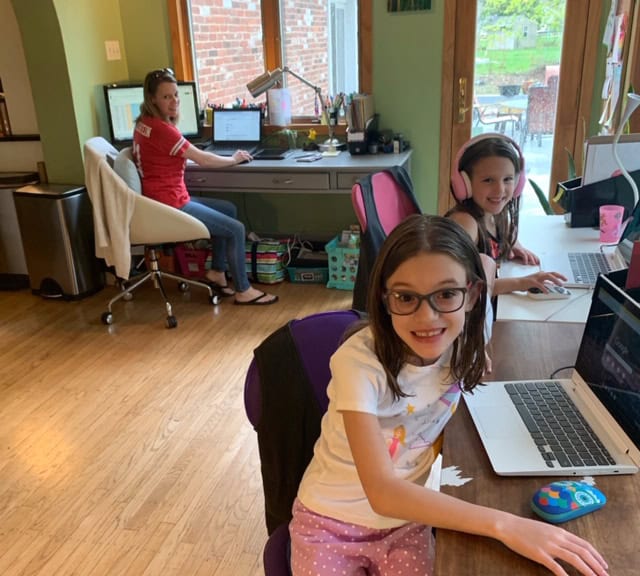

Molly Grimenstein is proof that learning never stops, and that the curve can be steep.
The second grade teacher at Elizabeth Haddon Elementary School, with 17 years of classroom experience at her disposal, has to contend with the requirements of the new distance learning model in the Haddonfield School District while keeping her own children focused during the school day.
“We started out in our dining room, and then we moved into the playroom so we have a giant space for learning and working,” Grimenstein said to the Sun on April 5, just before starting the fourth week of online instruction required because of school closures from the spread of coronavirus.
Grimenstein’s two children – one in second grade and one in third – attend school in Cherry Hill. As a result, she has to switch back and forth between both districts’ instructional offerings and navigate them simultaneously.
It can get confusing.
“I can see this from two different angles, because they are in the same grade I teach, but they use different programs than us,” she admitted. “Being a working parent, it’s tough being on a conference call, or Zoom conference and my kids are popping up at any time. Pretty much any teacher with kids is right along with other parents in coping with time management.
“For me, as a parent, even though I know the curriculum of second and third grades, it’s still been hard for me to juggle and balance. There are some long hours,” she added.
Shifting from the school environment structure to one where the tone is set by each individual household can also be a tricky proposition, especially with different classroom settings existing at the same time. Like others, the Grimensteins are finding their way.
“We’ve figured out our own routine through trial and error in terms of what time to get started and how and what times to get the help they need,” she said of her children. “They’ve been making their own checklist. As a parent I’ve been teaching them independence, and I hope my own students are learning with their own families.
“One thing I think we do well in Haddonfield is keeping up that face time with their peers,” Grimenstein added. “Kids really need that structure and routine from their parents and teachers, but they really crave that social interaction.”
Grimenstein has tried her best to maintain a sense of normalcy in her day-to-day lesson planning and interactions with her educational assistant; her 18 students; and their parents, despite a scattered setting.
“For me, now it looks dramatically different,” she explained. “I wanted to keep our morning meetings consistent. And we’re doing the same routines. We all sent the kids home with their whiteboards and while we’re on Zoom, I can screen share a message, and I think it’s very comforting for them.
“And kids write on their whiteboards and I can see their answers on the screen. That allows me to assess students properly,” Grimenstein added. “In terms of the amount of work, for the first two weeks, we did as much review as possible until teachers had more time for collaborating. We were having team meetings even when not required to keep on top of things.”
Grimenstein’s team is trying to come up with different ways to have valuable face time and crucial consultations for students’ work to maximize time and connectivity. They have sent out a survey to parents to see if what they have done so far is appropriate. In addition, they’re brainstorming ways to replace things like previously scheduled outdoor excursions to the zoo and to Greenfield Hall, which have been cancelled.
But Grimenstein admits that all the necessary online connectivity cannot replace real-world interaction, particularly with kids so young and in need of reassurance.
“I miss them,” she noted. “They’re my people. They laugh at my dumb jokes. It’s hard to not come in every day and see them. It’s hard to look at somebody and know they need a hug and I can’t give them a hug.
“What we do each day on Zoom will never replace that, but I can at least see their faces and know they’re fine.”
One thing is for certain: Online teaching and learning are nothing like summer vacation. If anything, teachers can be under more pressure to deliver the goods from afar.
“My husband remarked at one point, this is just like summer. I’m working 14-hour days right now; this is the exact opposite of summer,” Grimenstein added with a touch of exhaustion and annoyance.
“I’m working more now than I ever thought possible. I’m hoping as the weeks go on, it all becomes easier, since we’re learning how to streamline all the processes as we go along.”
Grimenstein has also found it interesting to note how a lot of district parents weren’t aware of what they had in the dedication of teachers – until it became time for the parents themselves to take the reins.
“We’ve gotten such great feedback from parents, the board of education and the administration,” she said. “They have been so supportive, telling us we’ve done a great job.
“It makes a ton of difference.”









